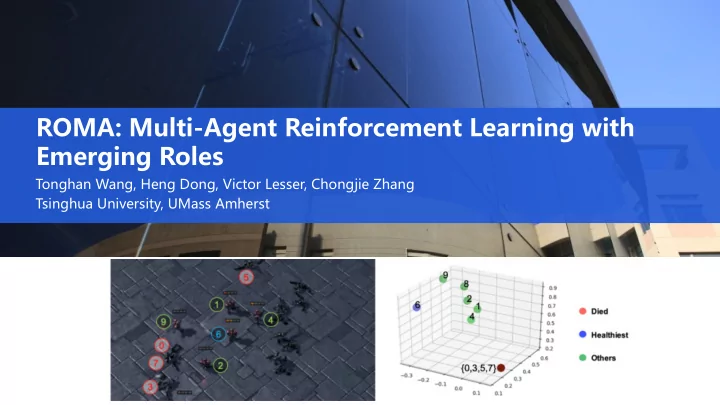

ROMA: Multi-Agent Reinforcement Learning with Emerging Roles Tonghan Wang, Heng Dong, Victor Lesser, Chongjie Zhang Tsinghua University, UMass Amherst
Multi-Agent Systems Robot Football Game Multi-Agent Assembly
One Major Challenge of Achieving Efficient MARL • Exponential blow-up of the state-action space – The state-action space grows exponentially with the number of agents. – Learning a centralized strategy is not scalable. • Solution: – Learning decentralized value functions or policies.
Decentralized Learning • Separate learning – High learning complexity: Some agents are performing similar tasks from time to time; • Shared learning – Share decentralized policies or value functions; – Adopted by most algorithms; – Can accelerate training.
Drawbacks of Shared Learning • Parameter sharing – Use a single policy to solve a task. – Inefficient in complex tasks. (Adam Smith’s pin factory.) • An important direction of MARL – Complex multi-agent cooperation needs sub-task specialization . – Dynamic learning sharing among agents responsible for the same sub-task.
Draw Some Inspirations from Natural Systems • Ants – Division of labor • Humans – Share experience among people with the same vocation.
Role-Based Multi-Agent Systems • Previous work – The complexity of agent design is reduced via task decomposition. – Predefine roles and associated responsibilities made up of a set of sub- tasks. • ROMA – Incorporate role learning into multi-agent reinforcement learning.
Outline 1. Motivation 2. Method 3. Results and Discussion
Our Idea • Learn sub-task specialization. • Let agents responsible for similar sub-tasks have similar policies and share their learning. • Introduce roles. Sub-Task Policies Roles Specialization
Our method • Connection between roles and policies – Generating role embeddings by a role encoder conditioned on local observations; – Conditioning agents’ policies on individual roles. • Connection between roles and behaviors – We propose two regularizers to enable roles to be: Identifiable by behaviors • Specialized in certain sub-tasks •
Identifiable Roles • We propose a regularizer to maximize ! " # ; % # & # • A lower bound: ( |" # ()* , & # ( ) 1 [log ; < (% # ( ; " # ()* |& # ( ) ≥ . / 0 !(% # ] 1 ,3 0 145 ,6 0 ( |& # ( ) =(% # • In practice, we optimize ( & # ( H; < % # ( " # ()* , & # ( ( |& # ( ) ℒ @ A / , B = . 3 0 1 ~E Fℰ = % # − J(% # 145 ,6 0
Specialized Roles • We expect that, for any two agents, – Either they have similar roles; – Or they have different behaviors, which are characterized by the local observation-action history. • However – Which agents have similar roles? – How to measure the dissimilarity between agents’ behaviors?
Specialized Roles • To solve this problem, we – Introduce a learnable dissimilarity model ! " – For each pair of agents, # and $ , seek to maximize % & ' ; ) * + ' + ! " (& * , & ' ) – Seek to minimize 0 " 1,2 , the number of non-zero elements in 0 " = ! *' , where ! *' = ! " (& * , & ' )
Specialized Roles • Formally, we propose the following role embedding learning problem to encourage sub-task specialization: minimize - + , & ' , ), * .,/ -=> ? 9 - + A , ; 9 -=> > C, - ; ; < -=> , ; < subject to 7 8 9 ∀E ≠ G • The specialization loss: ℒ I & ' , ), * = K L MNO ,P M ~I,R M ~'(T|P M ) -=> , C} - - |; < -=> , ? 9 - ) + A , ; 9 -=> , ; < + , W − X min{[ \ (8 9 9Y<
Overall Optimization Objective • Overall Optimization Objective – ℒ " = ℒ $% " + ' ( ℒ ( " ) , + + ' % ℒ % " ) , +, ,
Outline 1. Motivation 2. Methods 3. Results and Discussion
State-of-the-art performance on the SMAC benchmark
The SMAC Challenge
Ablation Study
Ablation Study
Role Representations
Dynamic Roles ! = 27 ! = 8 ! = 19 ! = 1
Specialized Roles • Learnable dissimilarity model: – Map: MMM2; – Different unit types have different roles; – Learned dissimilarity between trajectories of different unit types: 0.9556 ± 0.0009 ; – Learned dissimilarity between trajectories of the same unit type: 0.0780 ± 0.0019 .
Specialized Roles
Multi-Agent Reinforcement Learning with Emerging Roles
Role Emergence
Role Emergence
Game Replays
27m_vs_30m (27 Marines vs. 30 Marines)
For more experimental results. Welcome to our website: • https://sites.google.com/view/romarl
Recommend
More recommend